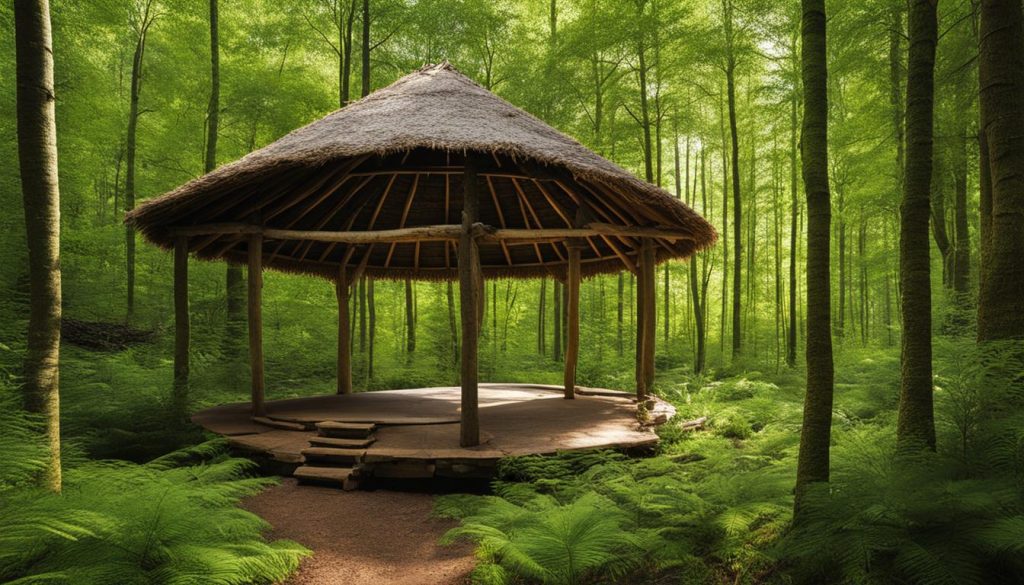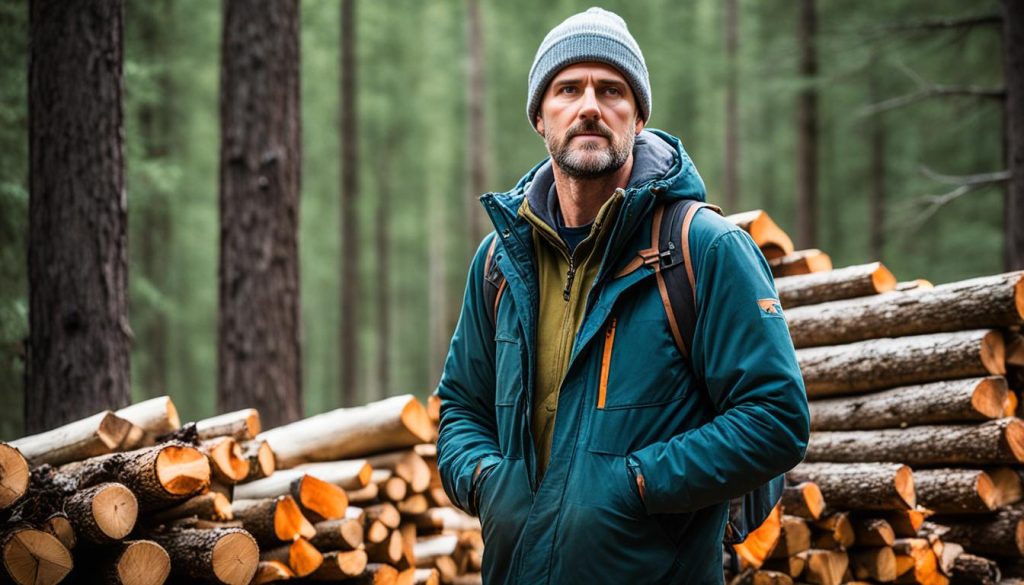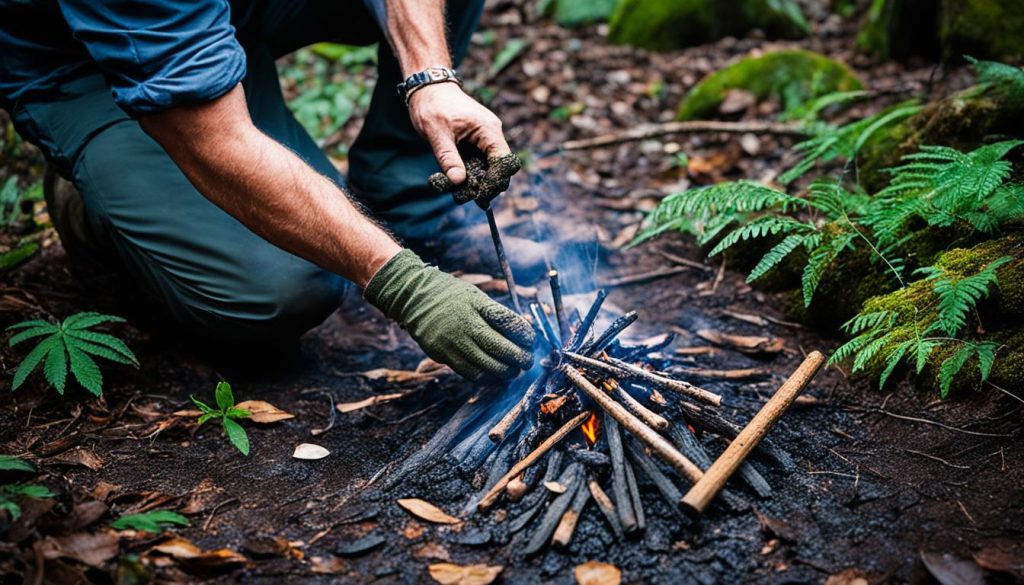Did you know that fire is not only a necessity for survival but also a key skill for outdoor enthusiasts? Whether you’re camping, hiking, or exploring the wilderness, knowing how to start a fire can be a matter of life or death. From lighting a campfire to mastering primitive fire-making techniques, the ability to ignite and maintain a fire is crucial for outdoor survival.
Key Takeaways:
- Fire is an essential skill for wilderness survival.
- Knowing multiple fire-starting techniques is crucial.
- Gathering the right materials is important for successful fire making.
- Understanding fire safety and building a shelter is essential.
- Practice and knowledge lead to wilderness fire making mastery.
The Importance of Fire in Survival Situations
Fire is an essential element for survival in the wilderness. Its significance cannot be overstated, as it provides numerous benefits that are crucial for outdoor adventurers. Let’s explore the importance of fire in survival situations and the various ways it contributes to enhancing outdoor survival skills.
One of the key benefits of fire in the wilderness is its multifunctional uses. Firstly, fire can purify water, making it safe for consumption. By bringing water to a boil, harmful bacteria and parasites are effectively killed, significantly reducing the risk of waterborne illnesses. This makes fire an indispensable tool for maintaining proper hydration and ensuring a safe water source.
Additionally, fire serves as a means to cook food, making it easier to digest and increasing its nutritional value. In wilderness survival, where food scarcity is a possibility, the ability to cook food on an open flame can provide essential sustenance and prevent malnutrition.
Furthermore, fire provides warmth and comfort, especially during cold weather conditions or chilly nights in the outdoors. It helps regulate body temperature and prevents hypothermia, enabling individuals to stay cozy and maintain their energy levels. The comforting glow and crackling sound of a fire also create a sense of companionship, bringing solace and reducing feelings of isolation in the wilderness.
In terms of safety, fire acts as a powerful signaling method to attract help or alert rescuers in an emergency situation. The smoke produced by a fire is highly visible, making it easier for search and rescue teams to locate individuals in need of assistance. This can be a lifesaver in remote areas where communication devices may not work.
Besides the practical advantages, fire also serves as a deterrent for predators. Its warmth and light help keep dangerous animals at bay, providing a sense of security and reducing the risk of wildlife encounters. In this way, fire promotes safety and peace of mind in the wilderness.
Building a Shelter for Fire Safety
When it comes to fire safety in the wilderness, building a shelter plays a crucial role. Not only does a well-constructed shelter protect the body from exposure to harsh weather conditions, but it also helps maintain body temperature, ensuring your survival in challenging environments.
When selecting a location for your shelter, it is important to consider various factors. Make sure to choose a spot that is free from debris and provides adequate protection from wind and rain. Keep in mind that the proximity of your shelter to the fire-making area is also essential for convenience and safety.
Wilderness shelter construction relies heavily on utilizing natural materials found in the surrounding environment. Sturdy branches, leaves, and other vegetation can be used to create a solid structure. By utilizing the resources around you, you can minimize the need to carry heavy equipment and ensure the effectiveness of your shelter.
Remember, the success of your fire-making endeavors is directly linked to the safety and durability of your shelter. Taking the time to build a well-constructed shelter will provide you with a secure and comfortable space, allowing you to focus on the process of fire starting.

The Importance of Shelter in Survival
Building a shelter is not only essential for fire safety but also plays a crucial role in overall survival. It provides a place of refuge and protection from the elements, allowing you to conserve energy and stay safe in challenging conditions.
“A well-built shelter can mean the difference between life and death in a survival situation.”
By constructing a shelter, you can avoid exposure to extreme temperatures, rain, snow, or blistering sunlight. This helps prevent hypothermia, heatstroke, and other weather-related illnesses, ensuring your well-being during your wilderness adventure.
Furthermore, a shelter provides a sense of security and boosts morale. It offers a space where you can rest, regroup, and plan your next move. In addition, having a shelter close to your fire-making area allows for quick access to warmth and vital resources.
Location for Fire Making
When selecting the location for your shelter, it is crucial to consider its proximity to the fire-making area. This allows for easy access to firewood, ensuring a constant supply to keep your fire burning strong.
Choosing a location that is a safe distance away from your shelter can help prevent accidental fires and minimize the risk of your shelter catching fire. Assess the wind direction and position your shelter accordingly to avoid smoke blowing directly into your living space.
By carefully considering the location of your shelter in relation to the fire-making area, you can maximize safety, convenience, and efficiency during your wilderness adventure.
| Potential Shelter Locations | Pros | Cons |
|---|---|---|
| Under a rock overhang or cave | – Natural protection from wind and rain – Ready-made structure to build upon | – Limited availability – Potential presence of animals |
| Among dense foliage | – Natural insulation and protection – Easy access to fire-making area | – Increased risk of insects or reptiles – Difficulty finding suitable branches for construction |
| Next to a large tree or fallen log | – Natural windbreak and protection – Easy access to fire-making area | – Limited space for maneuverability – Potential hazard if tree or log collapses |
Gathering Materials for Successful Fire Making
When it comes to fire making in the wilderness, gathering the right materials is crucial for success. Having the necessary fire-starting materials and supplies will ensure that you can ignite a fire even in challenging conditions. Here are the key elements you need to gather:
Fire Starters
- Lighters: A reliable and convenient option for igniting a fire.
- Matches: Waterproof matches are ideal for outdoor use.
- Flint and Steel: A traditional method for sparking a fire.
Tinder
Tinder refers to easily ignitable materials that catch fire quickly and sustain a flame. Natural tinder sources include:
- Dry leaves and grass
- Birch bark
- Pine needles
You can also use man-made tinder such as jute twine or dryer lint, which ignite easily and help sustain the flame.
Kindling and Fuelwood
To ensure that your fire grows and sustains, you’ll need a combination of small kindling and larger fuelwood:
- Dry twigs and small branches serve as small kindling, helping the flame grow.
- Larger kindling, such as thicker branches and sticks, provides sustained fuel for the fire.
- Fuelwood, which consists of larger logs, sustains the fire for a longer period.
Remember to collect dry and brittle materials, as they catch fire more easily and contribute to efficient fire making.
Having these essential fire-starting materials and supplies will significantly increase your chances of successfully starting and maintaining a fire in the wilderness.

Techniques and Tips for Starting a Fire
Starting a fire in wet conditions can be challenging, but with the right techniques and tips, it is not impossible. Here are some methods to help you ignite a fire even in damp environments:
1. Fire Tipi Design
Creating a fire tipi design is an effective way to start a fire. Begin by arranging your tinder in a cone shape in the center, leaving space for airflow. Surround the tinder with kindling, such as small dry twigs, in a teepee-like structure. This design encourages the flame to catch and grow, maximizing its chances of success.
2. Utilize Natural Materials
In wet conditions, it is crucial to find dry natural materials that can assist in fire ignition. Pine needles, moss, or birch bark make excellent insulation for your tinder bundle. These materials contain natural oils and resins that can help sustain the flame even in damp environments. Collect them from fallen trees or dry sheltered areas.
3. Tend to the Fire
Once you’ve successfully started a fire, proper maintenance is essential to keep it burning. Add fuelwood gradually, starting with smaller pieces and gradually increasing the size. This ensures a steady supply of fuel and prevents smothering the fire. Additionally, maintaining proper airflow by arranging the logs strategically allows the fire to breathe and burn efficiently.
To summarize, starting a fire in wet conditions requires specific techniques and materials. By using a fire tipi design, utilizing natural materials, and tending to the fire effectively, you can overcome the challenges of damp environments and successfully ignite and maintain a fire.

| Fire Ignition Techniques | Fire Starting Tips | Fire-Building Methods |
|---|---|---|
| Fire tipi design | Utilize natural insulation materials | Tending to the fire by adding fuelwood gradually |
| Flint and steel | Keep tinder and kindling dry | Properly arrange logs for airflow |
| Bow drill method | Use fire starters like waterproof matches or lighters | Establish a base of dry materials |
Conclusion
Mastering wilderness fire making is crucial for outdoor enthusiasts who value their outdoor survival skills and prioritize fire safety in the wilderness. By understanding the importance of fire in survival situations, adventurers can harness its multifunctional benefits for warmth, cooking, signaling, and protection.
Building a shelter is an essential step in fire safety, as it not only protects the body from the elements but also minimizes the risk of starting wildfires. Choosing a suitable location and using natural materials ensure effective shelter construction.
Gathering the right materials is key to successful fire making in the wilderness. From fire starters like lighters, matches, or flint and steel to tinder and kindling, each element plays a critical role in igniting and sustaining the flame. Collecting dry and brittle materials is essential for efficient fire making.
Utilizing effective fire-starting techniques and tips can help overcome challenges encountered in wet conditions. Creating a fire tipi, insulating with natural materials, and maintaining the fire’s airflow contribute to the longevity of the flame.
By honing their fire making skills through practice and knowledge, outdoor enthusiasts can achieve wilderness fire making mastery. This mastery not only enhances their overall outdoor survival skills but also ensures they are well-equipped to handle fire safely in the wilderness.
